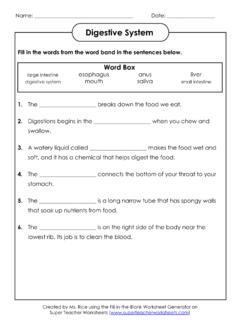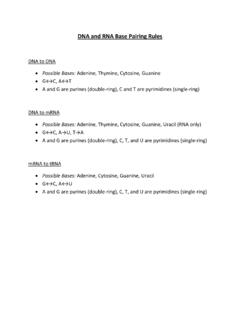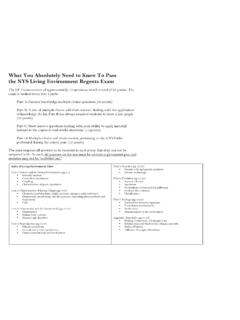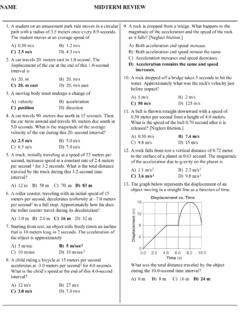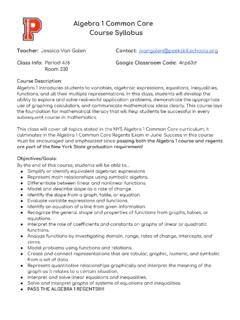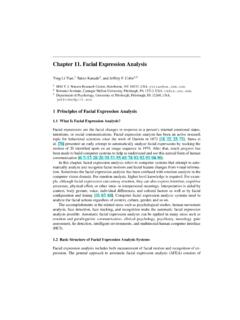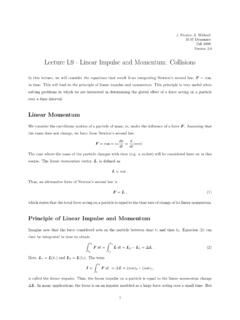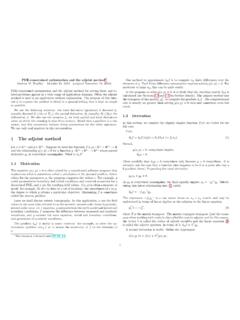Transcription of Chapter 4: Vector Addition
1 Homeward BoundA GPS receiver told you that your home km at a direction of40 north of west, but theonly path led directlynorth. If you took thatpath and walked 10 km,how far and in whatdirection would you thenhave to walk in a straightline to reach your home? Look at the ExampleProblem on page 75for the AdditionWHAT YOU LL LEARN You will represent vectorquantities graphically andalgebraically. You will determine the sumof vectors both graphicallyand IT S IMPORTANT Airplane pilots would find itdifficult or impossible tolocate their intended airportor estimate their time ofarrival without taking intoaccount the vectors thatdescribe both the plane svelocity with respect to theair and the velocity of the air (winds) with respect tothe find out more about vectors, visit the Glencoe Science Web site at , after hours of hiking and clambering up rocks, you vereached your destination. The scene you have been antici-pating unfolds before you.
2 It s the reward for the long trekthat has brought you here, and it s yours to enjoy. But no matter how inviting the scene, eventually the timecomes when you need to think about the journey home. It s veryeasy to lose track of directions in a region so vast. Suddenly thelandscape looks the same in every direction. Exactly where areyou, and in which direction is the way home?Unlike earlier adventurers who relied on the position of thesun and stars, you rely on a GPS receiver to help you find yourway home. The small, handheld device can pinpoint your locationwith an accuracy of 50 meters. The GPS receiver uses signals fromtwo dozen satellites of the Global Positioning System (GPS) todetermine location. The satellites are located in regular, stationaryorbits around the world. Each has a different displacement fromthe receiver. Thus, synchronized pulses transmitted from thesatellites reach a single receiver at different times.
3 The GPS receivertranslates the time differentials into data that provide the positionof the receiver. From that position, you can determine the displacement how far, and in what direction you need to travelto get from Chapter 3 that displacement is a Vector all vectors, displacement has both magnitude (distance) anddirection. In this Chapter , you ll learn how to represent vectorsand how to combine them in order to solve problems such asfinding your way home. In preparation for this Chapter , you maywant to look again at Appendix A and review some mathematicaltools, such as the Pythagorean theorem and trigonometric ratios. You ve learned that vectors have both a size, or magni-tude, and a direction. For some Vector quantities, themagnitude is so useful that it has been given its own name. Forexample, the magnitude of velocity is speed, and the magnitudeof displacement is distance. The magnitude of a Vector is always apositive quantity; a car can t have a negative speed, that is, a speed lessthan zero.
4 But, vectors can have both positive and negative directions. Inorder to specify the direction of a Vector , it s necessary to define a coordi-nate system. For now, the direction of vectors will be defined by the famil-iar set of directions associated with a compass: north, south, east, and westand the intermediate compass points such as northeast or Vector QuantitiesIn Chapter 3, you learned that Vector quantities can be represented byan arrow, or an arrow-tipped line segment. Such an arrow, having a spec-ified length and direction, is called a graphical representation of a vec-tor. You will use this representation when drawing Vector diagrams. Thearrow is drawn to scale so that its length represents the magnitude of thevector, and the arrow points in the specified direction of the printed materials, an algebraic representation of a Vector is oftenused. This representation is an italicized letter in boldface type. For exam-ple, a displacement can be represented by the expression d 50 km,southwest.
5 D 50 km designates only the magnitude of the resultant vectorTwo displacements are equal when the two dis-tances and directions are the same. For example, the two displacementvectors, Aand B,as shown in Figure 4 1,are equal. Even though theydon t begin or end at the same point, they have the same length anddirection. This property of vectors makes it possible to move vectorsgraphically for the purpose of adding or subtracting 4 1also shows two unequal vectors, C and they happen to startat the same position, they have different Determine graphically thesum of two or more vectors. Solve problems of relative of Vectors64 Vector AdditionTwo equal vectorsTwo unequal vectorsACDBFIGURE 4 1 Although they donot start at the same point, AandBare equal because they havethe same length and Conventions Displacement vectors are green. Velocity vectors are that a displacement is a change in position. No matter whatroute you take from home to school, your displacement is the 4 2shows some paths you could take.
6 You could first walk 2 kmsouth and then 4 km west and arrive at school, or you could travel 1 kmwest, then 2 km south, and then 3 km west. In each case, the displace-ment Vector , d,shown inFigure 4 2,is the same. This displacementvector is called a resultant Vector . A resultant is a Vector that is equalto the sum of two or more vectors. In this section, you will learn twomethods of adding vectors to find the resultant Addition of VectorsOne method for adding vectors involves manipulating their graphicalrepresentations on paper. To do so, you need a ruler to measure and drawthe vectors to the correct length, and a protractor to measure the anglethat establishes the direction. The length of the arrow should be propor-tional to the magnitude of the quantity being represented, so you mustdecide on a scale for your drawing. For example, you might let 1 cm onpaper represent 1 km. The important thing is to choose a scale that pro-duces a diagram of reasonable size with a Vector about 5 10 cm route from home to school shown inFigure 4 2involves trav-eling 2 km south and then 4 km 4 3shows how these twovectors can be added to give the resultant displacement, , vectorAis drawn pointing directly south.
7 Then, Vector Bis drawn with the tailof Bat the tip of Aand pointing directly west. Finally, the resultant isdrawn from the tail of Ato the tip of order of the Addition canbe reversed. Prove to yourself that the resultant would be the same if youdrew Bfirst and placed the tail of Aat the tip of magnitude of the resultant is found by measuring the length ofthe resultant with a ruler. To determine the direction, use a protractor tomeasure the number of degrees west of south the resultant is. How couldyou find the resultant Vector of more than two vectors?Figure 4 4shows how to add the three vectors representing the second path youcould take from home to school. Draw Vector C,then place the tail of Properties of Vectors65 HomeSchool4 km3 km2 km2 km1 kmdSEWNRBAFIGURE 4 2 Your displacementfrom home to school is the sameregardless of which route 4 3 The length of Ris proportional to the actualstraight-line distance from hometo school, and its direction is thedirection of the 4 4If you compare thedisplacement for route AB,shown in Figure 4 3,with thedisplacement for route CDE,youwill find that the displacementsare the tip of third Vector , E,is added in the same way.
8 Place thetail of Eat the tip of resultant, R,is drawn from the tail of Ctothe tip of the ruler to measure the magnitude and the protractorto find the direction. If you measure the lengths of the resultant vectorsin Figures 4 3 and4 4,you will find that even though the paths thatwere walked are different, the resulting displacements are magnitude of the resultantIf the two vectors to be added areat right angles, as shown inFigure 4 3,the magnitude can be found byusing the Pythagorean TheoremR2 A2 B2 The magnitude of the resultant Vector can be determined by calculatingthe square root. If the two vectors to be added are at some angle otherthan 90 , then you can use the Law of of CosinesR2 A2 B2 2 ABcos This equation calculates the magnitude of the resultant Vector from theknown magnitudes of the vectors Aand Band the cosine of the angle, , between 4 5shows the Vector Addition of that the vectors must be placed tail to tip, and the angle is theangle between AdditionR2 = A2 + B2 2AB cos RBAF inding the Magnitude of the Sum of Two VectorsFind the magnitude of the sum of a 15-km displacement and a 25-km displacement when the angle between them is 135.
9 Sketch the Problem Figure 4 5shows the two displacement vectors, Aand B,and the angle between Your AnswerKnown:Unknown:A 25 kmR ?B 15 km 135 Strategy:Use the Law of Cosines to findthe magnitude of the resultantvector when the angle does notequal 90 .Calculations:R2 A2 B2 2 ABcos (25 km)2 (15 km)2 2(25 km)(15 km)cos 135 625 km2 225 km2 750 km2(cos 135 ) 1380 km2R 1380 km2 37 kmFIGURE 4 5 The Law ofCosines is used to calculate themagnitude of the resultant whenthe angle between the vectors isother than 90 .Math HandbookTo review the Law ofCosinesand the Law ofSines,see the Math Handbook, Appendix A,page car is driven 125 km due west, then 65 km due south. Whatis the magnitude of its displacement? shopper walks from the door of the mall to her car 250 mdown a lane of cars, then turns 90 to the right and walks anadditional 60 m. What is the magnitude of the displacement ofher car from the mall door? hiker walks km in one direction, then makes a 45 turnto the right and walks another km.
10 What is the magnitudeof her displacement? is the magnitude of your displacement when you followdirections that tell you to walk 225 m in one direction, make a90 turn to the left and walk 350 m, then make a 30 turn tothe right and walk 125 m? Properties of Vectors67 Use your calculator to solve forRusing the Law of A2 B2 2 ABcos A 25 kmB 15 km 135 KeyResult62585037 Answer37 kmLaw of CosinesSubtracting VectorsMultiplying a Vector by a scalar number changes its length but not itsdirection unless the scalar is negative. Then, the Vector s direction isreversed. This fact can be used to subtract two vectors using the samemethods you used for adding them. For example, you ve learned that thedifference in two velocities is defined by this equation. v v2 v1 The equation can be written as the sum of two vectors. v v2 ( v1) 2( (x225x2)1515)13525 Check Your Answer Is the unit correct? The unit of the answer is a length.
